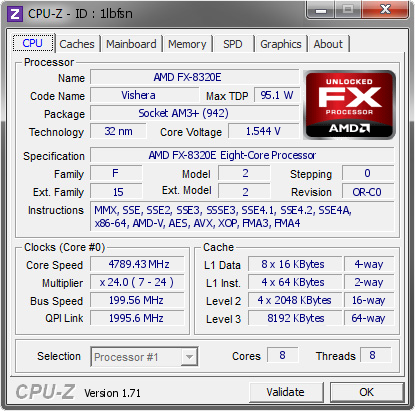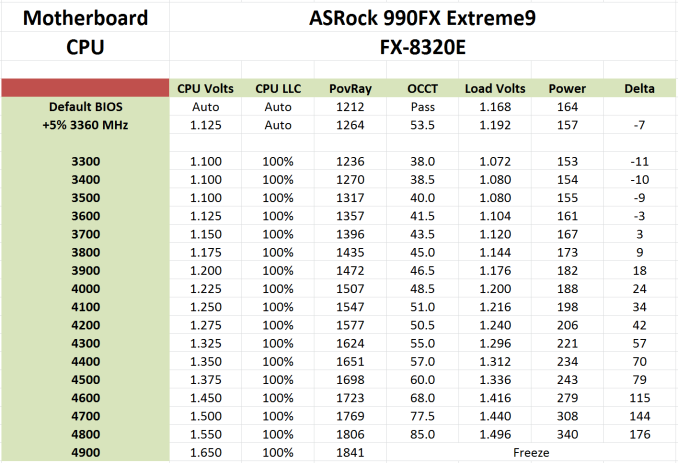AMD FX-8320E CPU Review: The Other 95W Vishera
by Ian Cutress on January 13, 2015 10:00 AM ESTAMD FX-8320E Overclocking
Sometimes looking at CPU overclocking performance is not that relevant. Each CPU ends up being different, and the plural of anecdote is not ‘data’. At some point it might be useful to sample 100+ CPUs of the same type and gain a proper scientific distribution of overclocks, but even then a sample size of 100 is quite small. So our single point in the ether might not matter too much, but the end result this time around was more than interesting.
To put this into perspective, our recent CPU samples here at AnandTech have been bottom of the barrel for our 24/7 validation methods. Our current i7-5960X does 4.4 GHz on a good day, and our fall-back stock testing model only does 4.2 GHz. Similarly we had an i7-4770K that only did 4.1 GHz – that was particularly shocking. Our last true good overclocker was a Sandy Bridge i7-2600K that did 5.3 GHz with a little push but sat at 5.1 GHz comfortably. Since then, horse plop is a nice word to describe it. However, that changed with our FX-8320E sample when paired with our AM3+ CPU test bed, the 990FX Extreme9.
As the voltage was increased, the frequency increased. It kept going, and going, and going. The Nepton 140XL CPU liquid cooler from CoolerMaster kept the temperature low (when I remembered to plug the fan in), but on the other hand the power started to rise. Almost every bump in frequency required an adjustment in voltage, but the increases were small.
At the end of the day, we rose from a 3.2 GHz base frequency all the way up to 4.8 GHz, a +50% overclock.
Methodology
Our standard overclocking methodology is as follows. We select the automatic overclock options and test for stability with PovRay and OCCT to simulate high-end workloads. These stability tests aim to catch any immediate causes for memory or CPU errors.
For manual overclocks, based on the information gathered from previous testing, starts off at a nominal voltage and CPU multiplier, and the multiplier is increased until the stability tests are failed. The CPU voltage is increased gradually until the stability tests are passed, and the process repeated until the motherboard reduces the multiplier automatically (due to safety protocol) or the CPU temperature reaches a stupidly high level (100ºC+). Our test bed is not in a case, which should push overclocks higher with fresher (cooler) air.
Overclock Results
The voltage at 4.8 GHz ran at an alarming 1.550 volts, and the system was stable during our testing when we rested all the benchmarks at this new marker. For 50% extra MHz, our POV-Ray scores jumped from 1212 to 1806, a near 50% jump as well. The only thing that jumped more than 50% was the power consumption. We measured an 86W idle to peak delta when at stock, but the final power was an additional +176W, or +205%, for a total 262W all in, pushing it above the FX-9590's TDP.
Actually in our graphs over the next few pages, the FX-9590 proved to be the best competition when overclocked. That being said, if I were using the CPU 24/7, 1.550 volts at 4.8 GHz would not be the best place to leave it. At 4.5 GHz the CPU only needed 1.375 volts for only a +79W power consumption. Depending on the power delivery of the motherboard, perhaps another couple of notches as well. But all four modules at 4.8 GHz was pretty much unexpected. As always, your mileage may vary.
One argument for our good overclocking sample takes many prongs. A cynic might suggest that this was pre-binned to give a good result, however our past samples from AMD has nothing to suggest that this was particularly special. Karma might suggest that it was just ‘our time’ to get a good sample. A pragmatist would suggest that the FX-8320E is a particularly highly binned part to begin with, and the 30W saving from the regular FX-8320 for only 300 MHz loss might work in its favor depending on how far the voltage curve goes. Again, as stated at the top of this page, it is hard to pin it down without a representative overclocking sample.
Test Setup
| Test Setup | |
| Processor | AMD FX-8320E 4 Modules, 8 Threads, 3.2 GHz, 4.0 GHz Turbo |
| Motherboards | ASRock 990FX Extreme9 |
| Cooling | Cooler Master Nepton 140XL |
| Power Supply | OCZ 1250W Gold ZX Series Corsair AX1200i Platinum PSU |
| Memory | G.Skill RipjawsZ 4x4 GB DDR3-1866 9-11-9 Kit |
| Memory Settings | XMP |
| Video Cards | MSI GTX 770 Lightning 2GB (1150/1202 Boost) |
| Video Drivers | NVIDIA Drivers 337 |
| Hard Drive | OCZ Vertex 3 256GB |
| Optical Drive | LG GH22NS50 |
| Case | Open Test Bed |
| Operating System | Windows 7 64-bit SP1 |
We are using our ASRock 990FX Extreme9 for testing consistency and comparison, despite AMD sampling the MSI 970 Gaming with this review unit. The motherboard and BIOS can affect the performance quite dramatically, and this keeps our numbers comparable to each other.
Many thanks to...
We must thank the following companies for kindly providing hardware for our test bed:
Thank you to OCZ for providing us with PSUs and SSDs.
Thank you to G.Skill for providing us with memory.
Thank you to Corsair for providing us with an AX1200i PSU.
Thank you to MSI for providing us with the NVIDIA GTX 770 Lightning GPUs.
Thank you to Rosewill for providing us with PSUs and RK-9100 keyboards.
Thank you to ASRock for providing us with some IO testing kit.
Thank you to Cooler Master for providing us with Nepton 140XL CLCs.
Load Delta Power Consumption
Power consumption was tested on the system while in a single MSI GTX 770 Lightning GPU configuration with a wall meter connected to the OCZ 1250W power supply. This power supply is Gold rated, and as I am in the UK on a 230-240 V supply, leads to ~75% efficiency > 50W, and 90%+ efficiency at 250W, suitable for both idle and multi-GPU loading. This method of power reading allows us to compare the power management of the UEFI and the board to supply components with power under load, and includes typical PSU losses due to efficiency.
We take the power delta difference between idle and load as our tested value, giving an indication of the power increase from the CPU when placed under stress.

86W undercuts the 95W TDP by a good margin, however one might suggest that the power efficiency difference of the power supply would take that into account. The stock load voltage was 1.168 volts in our motherboard, which does not suggest anything untoward regarding the VID.












92 Comments
View All Comments
Kevin G - Tuesday, January 13, 2015 - link
Updating the chipset is necessary to get new IO on to a platform. Things like USB 3.0 can then be integrated into the chipset so that a 3rd party controller is no longer needed.Rather the nice thing is that AMD hasn't changed socket in 5 years with AM3+. Intlel on the other hand has had three sockets of chips with dual channel DDR3, 16 PCIe lanes and DMI to the chipset. Sure, a few things changed between socket 1156, 1155 and socket 1150, but it would have been nice if Intel was forward thinking and maintained compatibility. The quad core Lynfield chips are still respectable in terms of CPU performance today.
Penti - Tuesday, January 13, 2015 - link
They has basically frozen their whole platform with the failed Bulldozer release. Their chipset's hasn't changed much since AM2+/AM3 days, the NB is basically the same as the 2007 790FX. The only thing 990FX added over 790FX is probably the IOMMU-support (and updated the PCIe lanes used by the SB to PCIe 2.0 also called A-link Express) which was first found in the identical 890FX, also IOMMU was found in server chipsets built on the 800-series back in '10. The southbridge on AM3+ hasn't changed since launch and is basically the same as the 2010 SB850. It's planned that they have a 4 year or so gap. They canceled a lot of designs and plans. Including new server socket and server chipset. They scrapped the plans for new BD chips for AM3+/successor socket also which is why you have no Steamroller or Excavator, and why you have no 10/20-core 2-gen Bulldozer/Piledriver for servers. So the chipset is really 5 years old and based on the same tech as 7 year old NB built on the same process and had HT3 support back then too. So the NB is really 2007-era with minor changes, SB has no USB3 support.Intel basically did have a platform which didn't get a chipset update for ~3 years – the X79. That wasn't such a good deal thanks to no native USB3 support, few SATA6 ports and so on. Lots of bugs too.
stefantalpalaru - Tuesday, January 13, 2015 - link
Here are a series of benchmarks I did on the same (rather modest) motherboard with a Phenom II X6 at 3.9 GHz and the FX-8320E at stock frequency and a 4.5 GHz overclock: http://openbenchmarking.org/result/1412036-KH-MERG...mikato - Wednesday, January 14, 2015 - link
Very cool! Thanks for this. If I interpret the colors correctly, it looks like the X6 wins mostly, but when the FX-8320E is overclocked, it wins mostly.LarsBars - Saturday, January 17, 2015 - link
I used some of the sorting tools and it looks like your summary is correct.But keep in mind that the Phenom II X6 is overclocked... so it's kind of hard to draw conclusions from it. I guess it would have made sense if it was stock vs stock (which we sort of already have in the AT article) or OC vs OC (since AT didn't OC an X6).
$0.02
SpaceRanger - Tuesday, January 13, 2015 - link
The only graph that I wanted to see was the power consumption graph, and it's not included.. :(I really wanted to see just how much they chopped off the power consumption with this go-around.
silverblue - Tuesday, January 13, 2015 - link
Toms benched the 8370E and appeared to get some very interesting power readings. Though this doesn't necessarily ring true for the 8320E, it may be helpful nonetheless:http://www.tomshardware.com/reviews/amd-fx-8370e-c...
sonicmerlin - Tuesday, January 13, 2015 - link
The most painful aspect of AMD's single threaded performance woes is that Intel hasn't even bothered with increasing IPC since Sandy Bridge. AMD needs their new architecture to be a smash hit if they want to avoid bankruptcy.silverblue - Tuesday, January 13, 2015 - link
And that's what bothers me about Carrizo not coming to the desktop. We don't know if that 30% IPC boost is across the board or mainly as a result of FPU gains, but at the very least, Carrizo should bury Phenom II and previous Bulldozer designs, and at least equal Lynnfield/Nehalem, at the same clocks but for far lower power consumption. Still, performance wise, it's not exactly a lofty goal - you'd need more than four cores for that.xenol - Tuesday, January 13, 2015 - link
Software most people use didn't take advantage of Bulldozer because they weren't multi-threaded. It's because software most people use don't take advantage of CPU performance period. Most of the programs in your task manager idle.Modern software is multi-threaded, as in, they have multiple threads. And all the major OSes (Windows, Linux, Mac OS X) schedule at the thread level on any available resource. If they don't take advantage of multiple cores, it's not because they are "single threaded", it's because what they do isn't very taxing for a CPU to do.